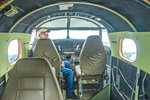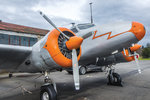Doug Platten's hobby sometimes leads him down intriguing pathways, like learning about the storied history of Sydney Cotton’s Lockheed 12A, which Platten has been working on for the past eight months with Scott Erickson, owner of Aurora Aircraft Maintenance (formerly Tailspin Tommy’s) at JCIA.
This item is available in full to subscribers.
We have recently launched a new and improved website. To continue reading, you will need to either log into your subscriber account, or purchase a new subscription.
If you had an active account on our previous website, then you have an account here. Simply reset your password to regain access to your account.
If you did not have an account on our previous website, but are a current print subscriber, click here to set up your website account.
Otherwise, click here to view your options for subscribing.
* Having trouble? Call our circulation department at 360-385-2900, or email our support.
Please log in to continue |
|


Doug Platten has been working on airplanes since he was 13 years old.
“My dad took me flying when I was a kid,” he said, sitting in the cockpit of an antique Lockheed 12A Electra Junior on the tarmac at Jefferson County International Airport. “Then I started riding my bike out to the airport near my house all the time. Eventually, they said, ‘Since you’re here all the time, we might as well put you to work.’”
Now a resident of Port Angeles, Platten can often be found at the local airports doing mechanical restoration work on antique planes.
“It’s a hobby for me,” he said. And his hobby sometimes leads him down intriguing pathways, like learning about the storied history of Sydney Cotton’s Lockheed 12A, which Platten has been working on for the past eight months with Scott Erickson, owner of Aurora Aircraft Maintenance (formerly Tailspin Tommy’s) at JCIA.
“Not only is it a unique aircraft—only 130 of them were ever made—but when we found out the history of it, that added a lot to it,” Platten said.
The silver and orange lighting-bolt-striped plane was built in 1936 in Burbank, California. It was purchased by Australian photographer Sydney Cotton and altered to carry cameras for high-resolution aerial photography. Cotton would pose as a film producer, businessman or archaeologist and fly to Germany, Sicily, Cairo, Malta and Libya before the beginning of WWII, working undercover for MI6. Because of his alterations to the plane, he could take aerial photos without the camera being seen.
That was how he ended up flying out of Berlin, just one week before Hitler invaded Poland in 1939—taking aerial photographs that documented German troop movements for Allied Intelligence.
“It was the last civilian aircraft to fly out of Berlin before the war started,” Platten said.
Cotton’s many adventures were documented in the book, “Aviator Extraordinary: The Sidney Cotton Story as told to Ralph Baker.”
Cotton is said to have been inspiration for his friend Ian Fleming, who wrote the James Bond spy novels.
When Cotton stopped flying the plane during the war, it sat at Heston Aerodrome west of London, one of England’s main airfields in WWII, before it was damaged in a German air raid. The plane was later returned to the U.S. where it was repaired and restored.
In the 1970s, it was sold to aerobatic pilot Art Scholl who worked as a stunt flyer for film and television. Scholl flew the Lockheed in several films such as “Doc Savage: The Man of Bronze,” “Freebie and the Bean” and the two-part TV mini series “Amelia Earhart.”
Today, the plane is still flyable, but it needed maintenance on the landing gear, propellers, fuel system and oil system.
It landed at Erickson’s hangar eight months ago. Now, after a propellor overhaul and fixed-up landing gear, it’s nearly ready to take off.
The hardest part, Platten said, was finding replacement parts for antique systems. Many of the parts either don’t exist, or are irreplaceable, making it a unique challenge to get the engine and landing gear in working order.
“I got to breathe life into some of the old components,” Platten said.
Erickson said the plane will be test flown at the end of the week, and then take off for California in a few weeks. It will later be put on display in a museum in France, Platten added.
Leader reporter Carmen Jaramillo contributed to this report.